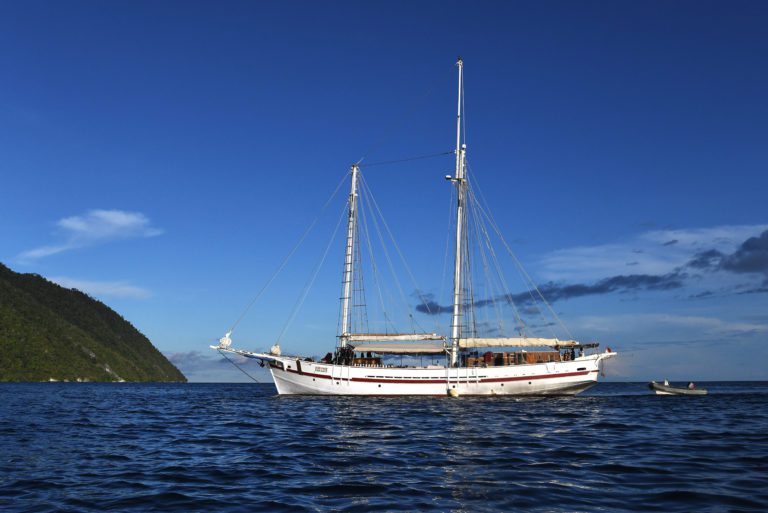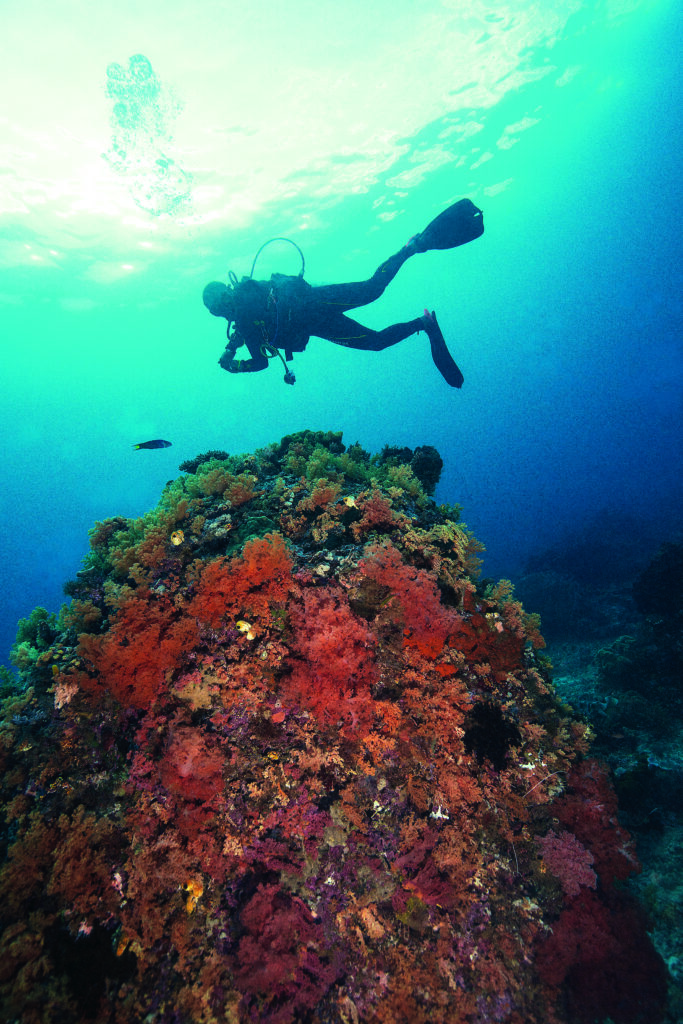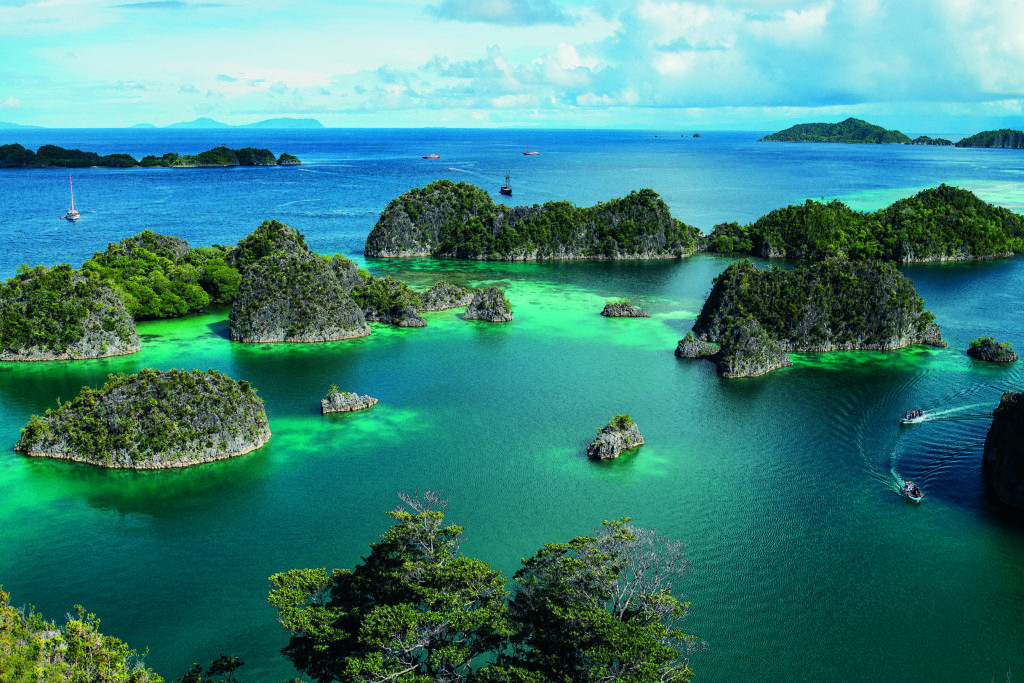Well-travelled photo-journalist AL HORNSBY thought he had seen everything, but a cruise around the dive-sites of Raja Ampat left him flabbergasted
I’m sitting on the shaded deck of the schooner Emperor Raja Laut, our dive-boat for the past seven days, as we head for the Indonesian port town of Sorong, our seemingly non-stop dive adventure having finally come to an end. The sea is glassy-flat, as it has been on most days of the cruise, the sky a deep blue, with just a few white clouds scattered here and there.
I’m trying to select those several “best” dives about which to write, but I’m finding it slightly bewildering, there having been so many, one following after another.
Diving categories & styles
Our run had taken us on a circuitous route through the more than 1,500 islands of Indonesia’s most-acclaimed diving area Raja Ampat (it means the Four Kings, in the local Bahasa language). For all its prodigious reputation as being at the centre of biodiversity in the Coral Triangle, with astounding numbers of fish, other marine creatures and individual species – I wasn’t prepared for what that actually meant until I had seen it for myself.
Our dives fell into several general categories. Some centred in and around channels, which bring in steady flows of nutrient, supporting massive stands of corals and gorgonian fans, huge schools of fish (the fusiliers of several species that covered large areas of reef were often too dense to see one’s way through) and the predators that feed on them.
Other sites were calm, island-side slopes, reef-flats and drop-offs, featuring prolific hard and soft corals, many fish species and lots of turtles, including unusual numbers of hawksbills.
The final, fun category could best be described as “the unique and the unexpected”.
With a variety of preferred styles of diving among the nine passengers, the dive-guides were very accommodating and generally ran three groups, especially on the high-current dives.
There would be one group that typically went deep and hooked on for longer periods when there was high current; another that preferred more gentle dives at more moderate depths; and my preferred group, which liked heading to the deep point, then moving about and hooking on at various times and places for brief moments when the current was really running.
It’s tough when trying to capture images simply to wait and hope that something will come along to get its picture taken!
Blue Magic
Back to my dilemma of which of the nearly 30 dives and related adventures (the trip was more than dive-dive-dive) to single out – I guess I have to start with Blue Magic in Dampier Strait, which we dived on the trip out and, happily, again on our return.
It was perhaps the most dramatic, high-current dive site, with a negative drop to 30m to the flow-facing point of a large, oblong coral mound where huge schools of fish moved about among the soft corals, in particular chevron barracuda and big-eye trevally.
Other schooling fish, especially mixed groups of snapper, spotted sweetlips, squirrelfish and spadefish, tended to gather toward the current, packed closely together, side by side, in large congregations – unlike anything I had seen elsewhere.
Drifting along toward shallower water to complete our multi-level profiles, we found massive coral gardens thick with different reef tropicals and surprising numbers of big bumphead parrotfish and Napoleon wrasse.
A reef-slope dive early into our trip was also the first of the several “unique and unexpected” dives we were to experience, off the Mansuar village of Sawandarek. Considering what was to come, it was a peaceful, rather innocuous place.
Its story was wonderful, however: a village that had decided to stop fishing and harvesting on its just-off-the-beach reef, and instead to centre its economic activities around welcoming visiting divers, plus creating a coral and giant clam nursery.
While certainly something I wanted to experience and support, it wasn’t the normal setting leading to super-high expectations for the diving and photography.
As we slipped into the calm, shallow water over a beautiful coral slope that angled down from the shoreline – my maximum depth was about 15m – everything changed. We found ourselves in the midst of huge schools of fish, by the thousands: ribbon, diagonal-banded and many-spotted sweetlips, blacktail snapper, wide-band fusiliers and more, again in congregations that I had never experienced anywhere before.
Their groupings extended up from the bottom to near the surface, forming columns and pillars of bright colour, the fish closely packed together in sinuous displays, barely moving in the slight current, utterly accepting of divers being within touching distance.
Scattered among them were longfin and circular spadefish and solitary giant sweetlips, and in crevices in the riotous coral garden were tasselled wobbegong sharks surrounded by glittering masses of tiny pearly cardinalfish; anemones with anemonefish; giant clams and hordes of other species.
The final surprise was found nearby under the town’s small wooden pier, where large clumps of hard and soft corals hung down, sheltering many sweetlips, rabbitfish and snapper; and the glowing blue ambient light created remarkable photographic possibilities.
Manta Sandy
By this point in the trip, the variety and breadth of the Raja Ampat experience was beginning to sink in, and our next special dive came soon afterwards.
In the Arborek Island area, kilometres from the islands to either side in a wide, meandering swathe of channels, we watched from the boat as the glassy surface gradually began to move. It swirled more and more as we progressed until we were within a tidal river of currents.
We began seeing the dark tips of manta wings breaking the surface in all directions, and that was when we knew we had reached Manta Sandy, an extraordinary dive-site.
Quickly dropping down to a rough white-sand and gravel channel bottom at 18m, we flew on the current. Within moments, a large manta came within a few metres of us from behind, with another soon arriving from the opposite direction.
We reached large stony-coral mounds scattered here and there along the shallower sides of the channel, and each one appeared to be a classic manta cleaning station. We would hook on, wait a few moments until the rays made close passes, then release and drift to the next mound, and repeat.
During our 60-minute dive, I was approached by, and made close, strobe-lit images of, at least eight large mantas, and saw numbers more outside of good photographic range. What was interesting is that they weren’t being cleaned, simply coming in for inquisitive looks at us. Marvellous, marvellous.
The walking shark
Our first night-dive was just off the Arborek jetty. Expectations were high, because this is a place where the endemic and unusual Raja epaulette, or walking shark, could sometimes be seen. We went in, onto a sand and rubble slope with scattered coral heads and sponges – classic, macro night-dive territory.
Almost immediately we began seeing the site’s denizens – small, stumpy-spined cuttlefish, flatworms, a strange banded sole and then an unusual sight – a gigantic, 40cm-long giant baler shell crawling over the bottom, its long proboscis extended.
Moving toward the shallows near dive’s end, we found a brilliant red fire-clam, and, if that wasn’t enough, a rather fearless night reef squid gave us a classic, curled-tentacles posture, resulting in photographs I had never made before.
Soon, my guide began quickly swimming up into the shallows – to no more than 1m – over a thick forest of antler coral just off the beach. I followed, inching along to avoid touching anything and aware that he was looking for something. Then I saw the waggling light signal, meaning that the “something” had been found.
Edging in close, there was the most lovely and unusual small shark I had ever seen, walking on its pectoral fins across the bottom, in and out of the coral branches – a Raja epaulette. It was delightful to watch.
The Passage
Perhaps our most unexpected dive of all occurred late in the trip, in an area called the Passage. Between a huge assemblage of large and small jungled islands rimmed with mangrove forests wound a kilometres-long series of twisting and turning narrow “rivers”, with interconnected “lakes”.
When we looked down through the clear water, large coral heads sprouted out of the sand bottom, and colourful soft corals hung from the limestone walls of the channels. This wasn’t an area of freshwater rivers and lakes, but rather the ocean moving between a complex cluster of upthrust islands.
After a thorough briefing for the rather complex dive, we entered a narrow channel where the current was fierce, though manageable when we tucked in close to the channel wall. We pulled ourselves along the bottom against the flow, the light muted under the branches of the overhanging trees.
Soft corals were everywhere, and schools of bumphead parrotfish meandered about, letting us in unusually close. Snapper, sweetlips and spadefish came in and out as we scrabbled along.
Then a cavern mouth opened to our right side, and we left the current for its still water. Just inside, a big school of pick-handle barracuda rested, moving slowly apart to allow us through. We ascended to find an open-air grotto with a few openings to the jungle above, light-beams streaming in.
Back out in the channel we continued along to find more caverns. The last one was our dive’s goal. At the back of the submerged chamber, a narrow, soft coral-festooned chimney angled upwards, just large enough for one diver at a time to slither through, to surface inside another large grotto.
A narrow crevice extending above and below the water-line opened to the Passage’s channel and to the bright sunlight reflecting from the trees on the jungled hillside beyond.
We spent the rest of the day in the dive inflatables, slowly motoring through the winding waterways hoping for a glimpse – and images – of one of the saltwater crocodiles that inhabit the area. We didn’t find one that day, but the incredible natural beauty of this unique area, and spotting herons, cockatoos and other birds, certainly sufficed.
I could also describe Melissa’s Garden, one of the most beautiful coral gardens I’ve ever seen, which also had blacktip sharks and schooling barracuda.
And I could mention further topside adventures, such as when we hiked up a high, island hillside in darkness to watch red birds of paradise in mating displays at dawn; or when we made our way to a peak at Pianemo, for the majestic, constantly published Raja Ampat signature view of green islands and turquoise waters. But I’ll save those and other Raja Ampat stories for another time.
Emperor Raja Laut: This 31m twin-masted schooner with 7.3m beam is a liveaboard built in classic Indonesian style, and is modern, roomy and utterly comfortable for its (maximum) 12 passengers. With six cabins, all with private bathrooms, full interior air-conditioning, a large, shaded deck area and great fresh, European and Indonesian cuisine (vegetarian guests can also be accommodated at every meal), its cruises would be a joy even without the quality of diving. Wi-fi is available, except in certain very remote areas.
The dive operation is also top-flight, with French and local dive leaders, nitrox, Scubapro rental equipment, very efficient gear-storage and kitting-up areas, and two fast RIBs for reaching dive-sites. For photographers there is an air-conditioned photo area with multiple charging stations. Find out more at Emperor Divers.
Diverse Travel: This specialist dive-tour operator creates tailored itineraries for its clients, and is operated by a small team of keen, well-travelled divers who have sampled the multitude of resorts, boats and destinations on offer. Whatever you want to achieve on a trip, the Diverse Travel team say they will work with guests to craft the perfect holiday.
Also on Divernet: Raja Ampat Q&A, Papua Paradise







This looks and sounds amazing – myself and a group of friends have this boat booked for a trip in February 2023 so it made interesting reading! Looking forward to the trip even more now!!